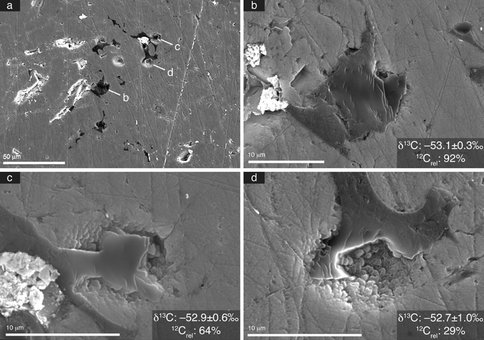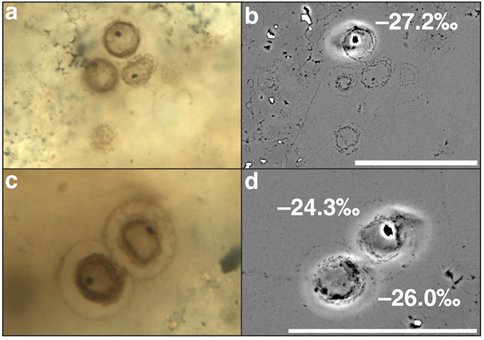2011 Annual Science Report
 University of Wisconsin
Reporting | SEP 2010 – AUG 2011
University of Wisconsin
Reporting | SEP 2010 – AUG 2011
Project 2D: Establishing Biogenicity and Environmental Setting of Precambrian Kerogen and Microfossils
Project Summary
Stable carbon isotope ratios preserved in ancient organic matter provide valuable information about the origin and evolution of metabolic pathways, and the evolution of the carbon cycle in general. In situ carbon isotope analysis allows organic matter to be measured in petrographic context. The microtexture and spatial relationship of sedimentary organic matter and its mineral matrix offers clues about source and diagenetic history – essential elements in the interpretation of isotopic data. We have developed protocols with the IMS-1280 ion microprobe to analyze carbon isotope ratios in organic matter with a spot size of 1–10 μm. A suite of new standards allows correction of matrix effects due to variable chemical composition. Four suites of Proterozoic microfossils of uncontested biogenicity have been analyzed, showing distinct values of δ13C that correlate with taxonomy and metabolism (Williford et al. 2011a in prep). Studies of kerogen and pyrobitumen from 2.7–2.5 Ga sediments support prior conclusions about differential impacts of aerobiosis and methane metabolisms in shallow versus deep-water depositional environments and reveal a degree of isotopic heterogeneity obscured by conventional, bulk analyses (Williford et al, 2011b in prep). Analysis of organic matter from the 3.35 Ga Strelley Pool Chert yield low and consistent values of δ13C, consistent with a biogenic origin (Lepot et al. 2011, in prep).
Project Progress
Three protocols have been developed to measure δ13C of organic matter: 1) 6 μm beam spots with two faraday cup (FC) detectors, 2) 1 μm beam with a FC for 12C and an electron multiplier (EM) for 13C, and 3) 10 μm, high intensity beam with one FC and one EM for materials with very low carbon concentration (including microfossils in chert). Average reproducibility (2 SD) for these three protocols is 0.4, 0.8, and 2.1‰, respectively. A series of experiments was conducted to assess the impact of variable H/C and mineral matrix on the accuracy of in situ organic carbon isotope measurements for the first two analytical protocols. These experiments led to the development of a suite of 12 standard organic materials with a wide range of H/C. A subset of these standards is analyzed at the beginning of each session to calibrate the relationship of 13CH/13C to instrumental bias and allows correction factors to be applied based upon 13CH/13C measurements made on each spot during δ13C analysis of samples. A suite of carbonaceous cherts with a range of H/C is being evaluated to assess this effect for the high intensity beam conditions used to analyze microfossils, and this will allow a similar calibration if necessary. In terms of mineral matrix effects, we find that reproducibility is stable at 12C count rates down to ~10% that of the standard for the first two protocols, and ~25% of the standard for the microfossil protocol. Additionally, we have demonstrated that it is possible with a 6 μm beam to analyze small organic carbon domains together with up to 70% carbonate mineral matrix with the same reproducibility as analyses made in a silicate matrix, due to the extremely low ionization efficiency and lower© of carbonate relative to organic carbon.
1. In situ carbon isotope analysis of Archean kerogen
More than 100 in situ analyses of kerogen and pyrobitumen from samples of the SV1 (Tumbiana Formation, ~2.7 Ga), WRL1 (Wittenoom Formation, Marra Mamba Iron Formation, and Jeerinah Formation, ~2.6 Ga), RHDH2a (Carrawine Dolomite and Jeerinah Formation, ~2.6 Ga) and ABDP-9 (Mount McRae Shale, ~2.5 Ga) drill cores have revealed significant μm-scale heterogeneity in δ13C. Pyrobitumen nodules around a central, uraniferous mineral grain are typically 13C-enriched compared to kerogen without such mineral associations in the same sample. Overall, these results support previous evidence for depth gradients in oxidation driven by oxygenic photosynthesis and methane metabolisms in Neoarchean environments.
2. In situ carbon isotope analysis of Proterozoic microfossils
More than 50 in situ δ13C analyses were made of Proterozoic microfossils from the Gunflint (1880 Ma), Bitter Springs (850 Ma), Min’yar (740 Ma), and Chichkan (650 Ma) Formations. Average reproducibility based upon ~50 analyses of a carbonaceous chert from the Fig Tree Group (3250 Ma) was 2‰ (2 SD). Microfossils from individual localities showed up to 10‰ variability in δ13C, and average δ13C of microfossils was similar to average bulk δ13Corg. Taxonomic and anatomical trends in microfossil δ13C are apparent and likely result from metabolic and biosynthetic differences. This is the initial phase of a comprehensive study of Proterozoic microfossil preservation that will incorporate in situ carbon isotope analysis, laser Raman, confocal laser scanning microscopy, and other techniques.
Fig. 1. In situ carbon isotope analyses of organic matter in the Carrawine Dolomite. Overview image in (a) shows distribution of organic matter in carbonate mineral matrix and indicates analytical pits enlarged in b-d. 12Crel refers to the 12C count rate for a sample analysis relative to the average 12C count rate for analyses of the bracketing standard (anthracite coal). Areas shown in b-d contain varying concentrations of organic matter in carbonate and have identical δ13C within error.
Fig. 2. Optical (a,c) and backscattered electron (b,d) images showing in situ carbon isotope analyses of microfossils from the Bitter Springs Formation (850 Ma). Analytical pits are visible in b and d. Scale bars are 50 mm.
Publications
- Williford, K.H., Ushikubo, T., Lepot, K., Hallmann, C., Spicuzza, M.J., Eigenbrode, J.L., Summons, R.E. & Valley, J.W. (2011). Spatially resolved, in situ carbon isotope analysis of Archean organic matter. American Geophysical Union Fall Meeting.
-
PROJECT INVESTIGATORS:
-
PROJECT MEMBERS:
Brian Beard
Co-Investigator
Noriko Kita
Co-Investigator
Huifang Xu
Co-Investigator
Philipp Heck
Postdoc
Kenneth Williford
Postdoc
John Fournelle
Research Staff
Jim Kern
Research Staff
Hiromi Konishi
Research Staff
Reinhard Kozdon
Research Staff
Mike Spicuzza
Research Staff
Takayuki Ushikubo
Research Staff
Jason Huberty
Graduate Student
-
RELATED OBJECTIVES:
Objective 4.1
Earth's early biosphere.
Objective 7.1
Biosignatures to be sought in Solar System materials


